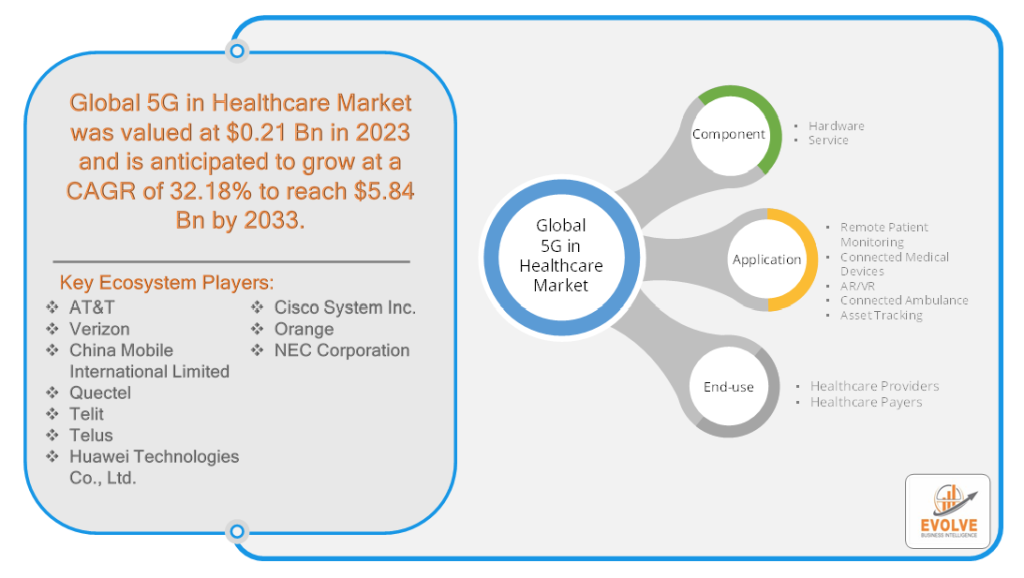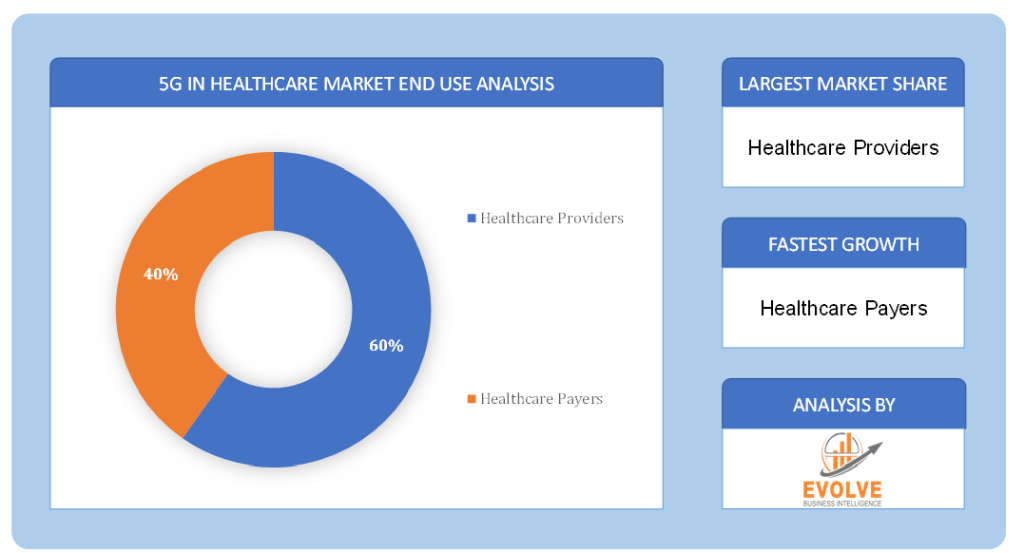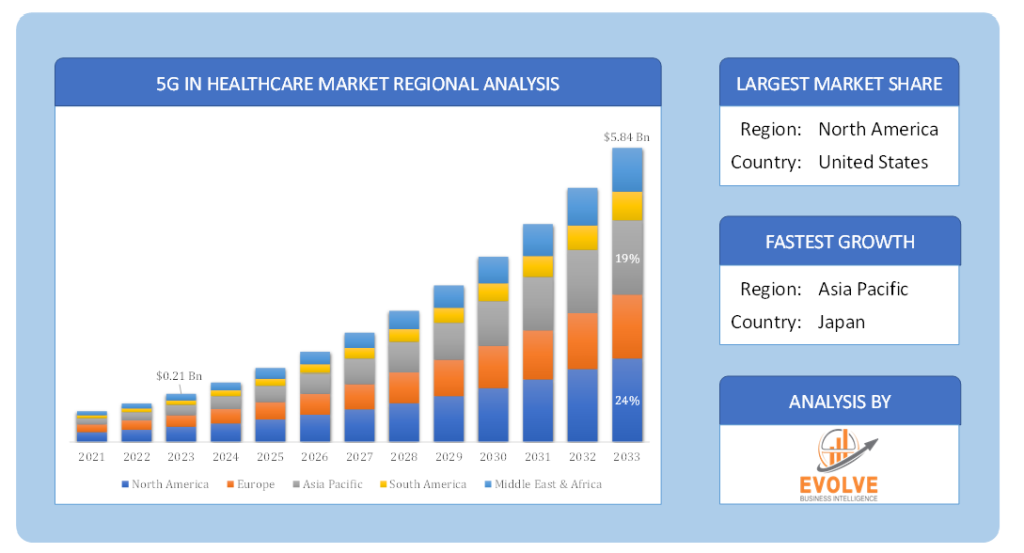5G in Healthcare Market Analysis and Global Forecast 2023-2033
$1,390.00 – $5,520.00Price range: $1,390.00 through $5,520.00
5G in Healthcare Market Research Report: By Component (Hardware, Service), By Application (Remote Patient Monitoring, Connected Medical Devices, AR/VR, Connected Ambulance, Asset Tracking), By End-use (Healthcare Providers, Healthcare Payers), and by Region — Forecast till 2033
[vc_row][vc_column width=”2/3″][vc_column_text woodmart_inline=”no” text_larger=”no”]
5G in Healthcare Market Overview
The 5G in Healthcare Market Size is expected to reach USD 5.84 Billion by 2033. The 5G in Healthcare industry size accounted for USD 0.21 Billion in 2023 and is expected to expand at a compound annual growth rate (CAGR) of 32.18% from 2023 to 2033. 5G in healthcare refers to the utilization of fifth-generation wireless technology to enhance and revolutionize healthcare delivery. With its high-speed data transfer and low latency, 5G enables healthcare professionals to access and transmit large medical files rapidly, facilitating remote diagnostics, telemedicine, and real-time collaboration. It empowers the implementation of emerging technologies like augmented reality (AR) and virtual reality (VR) in surgical procedures, medical training, and patient rehabilitation. Additionally, 5G supports the seamless integration of Internet of Things (IoT) devices and wearables, facilitating remote patient monitoring, data collection, and analysis for personalized and proactive healthcare. Overall, 5G technology has the potential to drive significant advancements in healthcare by improving efficiency, accessibility, and patient outcomes.
Global 5G in Healthcare Market Synopsis
The COVID-19 pandemic had a notable impact on the 5G in Healthcare market, leading to disruptions and challenges. While the potential of 5G in healthcare was widely recognized, the pandemic hindered its widespread adoption and implementation due to various factors. The global healthcare industry faced unprecedented strain and priorities shifted towards immediate response and containment efforts, diverting attention and resources away from the development and deployment of 5G solutions. Moreover, lockdown measures and restrictions on movement hampered the infrastructure development required for 5G networks. Additionally, the pandemic highlighted the need for robust cybersecurity measures in healthcare, adding another layer of complexity to the integration of 5G technology. However, despite the challenges, the pandemic also highlighted the importance of advanced digital healthcare solutions, and as the world recovers, the potential of 5G in revolutionizing healthcare delivery remains promising.
Global 5G in Healthcare Market Dynamics
The major factors that have impacted the growth of 5G in Healthcare are as follows:
Drivers:
⮚ Increased Connectivity and Data Transfer Speeds
One of the main drivers of the 5G in Healthcare market is the significantly increased connectivity and data transfer speeds offered by 5G networks. With the ability to transmit large volumes of data quickly and with low latency, 5G enables healthcare professionals to access and share medical records, images, and other critical information in real-time, facilitating telemedicine, remote consultations, and faster decision-making processes.
Restraint:
- Infrastructure Development Costs
The high costs associated with the development and deployment of 5G infrastructure. Implementing 5G networks requires significant investments in upgrading existing infrastructure and building new communication towers and base stations. These costs can be especially challenging for smaller healthcare facilities or those in remote areas, potentially delaying the widespread adoption of 5G technology in healthcare.
Opportunity:
⮚ Advancements in Telemedicine and Remote Patient Monitoring
5G presents a significant opportunity for advancements in telemedicine and remote patient monitoring. With its high-speed and low-latency capabilities, 5G allows for seamless real-time video consultations between patients and healthcare providers, improving access to medical care, especially in rural and underserved areas. It also enables the integration of various medical IoT devices and wearables, facilitating remote patient monitoring and continuous health data collection for personalized and proactive healthcare solutions. This can lead to better disease management, reduced hospital readmissions, and improved patient outcomes.
5G in Healthcare Market Segment Overview
By Component
Based on the Component, the market is segmented based on Hardware, Service. The Service segment was projected to hold the largest market share in the 5G Healthcare market. This is primarily due to the growing demand for managed services, consulting services, and support services to implement and manage 5G solutions in healthcare settings. Service providers play a crucial role in assisting healthcare organizations in deploying 5G networks, integrating them with existing infrastructure, ensuring network reliability and security, and offering continuous support and maintenance.
By Application
Based on Application, the market has been divided into Remote Patient Monitoring, Connected Medical Devices, AR/VR, Connected Ambulances, and Asset Tracking. The Remote Patient Monitoring segment is expected to hold the largest market share in the Market. It signifies the growing significance of remote patient monitoring solutions powered by 5G technology. Remote patient monitoring involves the use of connected devices and wearables to collect real-time health data from patients in their homes or other remote locations. With 5G’s high-speed, low-latency, and reliable connectivity, healthcare providers can access and analyze patient data in real time, enabling proactive and personalized healthcare interventions.
By End-use
Based on End-use, the market has been divided into Healthcare Providers, Healthcare Payers. The Healthcare Providers segment is projected to experience significant growth in the 5G in Healthcare market. This indicates the increasing adoption of 5G technology by healthcare providers, such as hospitals, clinics, and medical institutions, to enhance their healthcare services. Healthcare providers are recognizing the potential of 5G networks to improve patient care, enable real-time communication and collaboration among healthcare professionals, and support advanced technologies like telemedicine, remote diagnostics, and surgical procedures.
Global 5G in Healthcare Market Regional Analysis
Based on region, the market has been divided into North America, Europe, Asia-Pacific, the Middle East & Africa, and Latin America. The area of North America is anticipated to dominate the market for the usage of 5G in Healthcare, followed by those Asia-Pacific and Europe.
 North America Market
North America Market
North America has historically dominated the market share in the 5G Healthcare market. The region’s dominance can be attributed to several factors. Firstly, North America has been at the forefront of technological advancements, including the deployment of 5G networks. The U.S., in particular, has made significant investments in 5G infrastructure and has a highly developed healthcare sector. Additionally, North America has a strong ecosystem of technology providers, healthcare organizations, and regulatory frameworks that support the integration of 5G in healthcare applications. The region’s focus on innovation, research and development, and collaborations between healthcare and technology companies has further contributed to its leadership in the 5G in Healthcare market.
Asia Pacific Market
The 5G in Healthcare industry in the Asia-Pacific region has been experiencing remarkable growth. Several factors contribute to this trend. Firstly, the Asia-Pacific region has a large population and a rapidly aging population, which increases the demand for advanced healthcare services. 5G technology enables healthcare providers to deliver remote healthcare services, telemedicine, and remote patient monitoring, addressing the healthcare needs of a vast population. Additionally, countries in the Asia-Pacific region, including China, South Korea, and Japan, have been at the forefront of 5G network deployments and technological advancements. These countries have made significant investments in 5G infrastructure and have established supportive regulatory frameworks.
Competitive Landscape
The competitive landscape includes key players (tier 1, tier 2, and local) having a presence across the globe. Companies such as AT&T, Verizon, China Mobile International Limited, Quectel, and Telit are some of the leading players in the global 5G in the Healthcare Industry. These players have adopted partnership, acquisition, expansion, and new product development, among others as their key strategies.
Key Market Players:
- AT&T
- Verizon
- China Mobile International Limited
- Quectel
- Telit
- Telus
- Huawei Technologies Co., Ltd.
- Cisco System Inc.
- Orange
- NEC Corporation
Key development:
In May 2022, O2 Telefónica introduced a 5G standalone (SA) network within a hospital in Germany, aiming to enhance the effectiveness of current medical systems. The project focuses on optimizing efficiency and performance within the healthcare setting.
In January 2022, Thailand unveiled the first 5G smart hospital in the Association of Southeast Asian Nations (ASEAN). The initiative, known as the ‘Siriraj World Class 5G Smart Hospital,’ was a collaborative effort between the Thailand Office of The National Broadcasting and Telecommunications Commission (NBTC), Siriraj Hospital, and Huawei Technologies (Thailand) Co., Ltd.
Scope of the Report
Global 5G in Healthcare Market, by Component
- Hardware
- Service
Global 5G in Healthcare Market, by Application
- Remote Patient Monitoring
- Connected Medical Devices
- AR/VR
- Connected Ambulance
- Asset Tracking
Global 5G in Healthcare Market, by End-use
- Healthcare Providers
- Healthcare Payers
Global 5G in Healthcare Market, by Region
- North America
- US
- Canada
- Mexico
- Europe
- UK
- Germany
- France
- Italy
- Spain
- Benelux
- Nordic
- Rest of Europe
- Asia Pacific
- China
- Japan
- South Korea
- Indonesia
- Austalia
- Malaysia
- India
- Rest of Asia Pacific
- South America
- Brazil
- Argentina
- Rest of South America
- Middle East & Africa
- Saudi Arabia
- UAE
- Egypt
- South Africa
- Rest of Middle East & Africa
| Parameters | Indicators |
|---|---|
| Market Size | 2033: $5.84 Billion |
| CAGR | 32.18% CAGR (2023-2033) |
| Base year | 2022 |
| Forecast Period | 2023-2033 |
| Historical Data | 2021 |
| Report Coverage | Revenue Forecast, Competitive Landscape, Growth Factors, and Trends |
| Key Segmentations | Component, Application, End-use |
| Geographies Covered | North America, Europe, Asia-Pacific, Latin America, Middle East, Africa |
| Key Vendors | AT&T, Verizon, China Mobile International Limited, Quectel, Telit, Telus, Huawei Technologies Co., Ltd, Cisco System Inc, Orange, NEC Corporation |
| Key Market Opportunities | • Advancements in telemedicine and remote patient monitoring • Integration of Internet of Things (IoT) devices and wearables with 5G networks |
| Key Market Drivers | • Increased demand for faster and more reliable connectivity • 5G enables real-time access |
REPORT CONTENT BRIEF:
- High-level analysis of the current and future 5G in Healthcare Industry trends and opportunities
- Detailed analysis of current market drivers, restraining factors, and opportunities analysis in the future
- Historical market size for the year 2021, and forecast from 2023 to 2033
- 5G in Healthcare market share analysis for each segment
- Competitor analysis with a comprehensive insight into its product segment, financial strength, and strategies adopted.
- Identifies key strategies adopted by the key players including new product development, mergers and acquisitions, joint ventures, collaborations, and partnerships.
- To identify and understand the various factors involved in the global 5G in Healthcare market affected by the pandemic
- To provide year-on-year growth from 2022 to 2033
- To provide short-term, long-term, and overall CAGR comparison from 2022 to 2033.
- Provide Total Addressable Market (TAM) for the Global 5G in Healthcare Market.
[/vc_column_text][vc_column_text woodmart_inline=”no” text_larger=”no”]
Frequently Asked Questions (FAQ)
[/vc_column_text][woodmart_accordion][woodmart_accordion_item title=”What is the study period of this market?
“]The study period of the global 5G in Healthcare market is 2022- 2033[/woodmart_accordion_item][woodmart_accordion_item title=”What are the 10 Years CAGR (2023 to 2033) of the global 5G in Healthcare market?
“]The global 5G in Healthcare market is growing at a CAGR of ~18% over the next 10 years[/woodmart_accordion_item][woodmart_accordion_item title=”Which region has the highest growth rate in the market of 5G in Healthcare?
“]Asia Pacific is expected to register the highest CAGR during 2023-2033[/woodmart_accordion_item][woodmart_accordion_item title=”Which region accounted for the largest share of the market 5G in health care?
“]North America holds the largest share in 2022[/woodmart_accordion_item][woodmart_accordion_item title=”Major Key Players in the Market of Stem Cell Manufacturers?
“]AT&T, Verizon, China Mobile International Limited, Quectel, Telit, Telus, Huawei Technologies Co., Ltd, Cisco System Inc, Orange, and NEC Corporation are the major companies operating in the 5G in Healthcare[/woodmart_accordion_item][woodmart_accordion_item title=”Do you offer Post Sale Support?
“]Yes, we offer 16 hours of analyst support to solve the queries[/woodmart_accordion_item][woodmart_accordion_item title=”Do you deliver sections of a report?
“]Yes, we do provide regional as well as country-level reports. Other than this we also provide a sectional report. Please get in contact with our sales representatives[/woodmart_accordion_item][/woodmart_accordion][/vc_column][vc_column width=”1/3″][vc_column_text woodmart_inline=”no” text_larger=”no”][html_block id=”3961″][/vc_column_text][vc_wp_text]
Press Release
[rpwe limit=”10″ thumb=”true”][/vc_wp_text][/vc_column][/vc_row]






